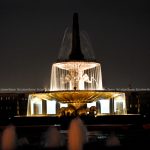History in the Making
Aishbagh Eidgah Allows Women to Offer Namaz Within the Walls
On that February evening, the day melted from the colour of dried blood to that of lead, even in the auditorium of the Scientific Convention Center, for there was roof- an open-air auditorium it was. The columns, the stage, the seats, the seated, all soaked up in the grey of the evening hue. The seats were filled by the who’s who of Urdu Literature, a majority of them being women. The occasion was a Literary Festival that had a session on Marsiyakhwani, the lost art of storytelling; the entire panel on the stage, women. The volunteers thronged the steps of the hall that descended onto the seating area. They heard in rapt attention as the ladies unfolded the untouched aspects of human nature. A panelist was in the midst of her narration when the muezzin filled the air of that lead with the sound of azaan. Almost immediately, and definitely in unison, the volunteers saw the women, both at the microphone, on the stage and in the audience, covering their head with their scarves. The speaker stopped at once and the silence prevailed for the following minute till the azaan was over.
For many present there, it was the first sight of dedication of the Muslim women towards their faith. The men could be spotted frequently, but imagine an entire auditorium filled with women, abandoning all the noises and voices and wrapping their head as if simultaneously reading one another’s minds…and this followed by a silence in respect of the ‘call’.
This sight would no longer be an uncommon one in Lucknow though.7th of July, 2016 would certainly be remembered as a special day in the lives of the women in Lucknow, as they got an opportunity to offer Namaz on the occasion of Eid-ul-Fitr at the iconic Aishbagh Eidgah for the very first time in history. A separate arrangement was made for the women to offer the Namaz at the Tayyab Hall. This gives a vehement encouragement to the minstrels of ‘gender equality’ in Islam.
Hundreds of women stood shoulder to shoulder (figuratively) with men to offer namaz for Eid at Lucknow’s three hundred year-old Aishbagh Eidgah. This marks a victory for women who have been fighting for their right to enter religious places. This turns out to be a good riddance from the chauvinistic demeanor of Islam.
Before this, the facility for women to offer namaz on Eid was not more than six average adult women, but after a jeering demand from the community, the new establishment can accommodate approximately 7000 people. It was a welcome decision taken by Maulana Khalid Firangi Mahali.
This move comes as a cause of celebration for women who are still fighting for their right of entry into the Haji Ali Dargah in Mumbai, the inner sanctum of Shani Shingnapur temple in Maharashtra, and the Sabarimala temple in Kerala. And ironically, they have to fight these restrictions when the religions themselves never laid them. The move comes at a time when instances of women being denied entry to Haji Ali Dargah and sanctum sanctorum at Shani temple in Maharashtra have made headlines with women organisations demanding equal rights on access to places of worship at par with their male counterparts.
Some might speculate that in the long run, this might be as ineffective as the previous attempts and a small change overall. And though there has been no complete barring of women to pray in mosques and Eidgah in Islam, the encouragement has been absent all the more. It’s against this backdrop that the Aishbagh Eidgah case needs to be welcomed. Plus, it also counters the radical elements within the Muslim ummah who want to keep their women behind closed doors, and also a wakeup call to the women who submitted themselves to the will of these radicals.
While women offering prayers at a mosque or Eidgah isn’t unusual, for over a decade, barely a few dozens have turned up to take part in the communal prayers. However, with an increase in requests to accommodate more of them, Maulana Khalid Firangi Mahali provisioned for a larger space this year.
Two gates were allotted for the entry of women at the Eidgah and provisions for mats, wazu and so on were made. On the occasion of Eid, over four lakh men show up, and that’s why the new provisions ensure the maintenance of purdah and that the women get a hassle-free access to the premises. Separate entry gates were a measure to make sure that both the above criteria are carried out effectively and without violation.
Given the debate on gender disparity in Islam, typically pertaining to women’s rights in various spheres of their lives including divorce, the cleric said the decision to welcome more women by making special provisions for them was a way to show that they weren’t disregarded in the community.
Although the purdah is maintained, what a sight it would be when the day melt into the hues of crimson and violet before slowly dissolving into the black, the voids of the evening air filled with the call of the azaan again, and a thousand hands wrapping a thousand heads with a thousand dupattas, pallus, and hijabs, the grace of the feminine raising hands to caress the fabric of faith, a thousand heads rising and falling before the Almighty! And that’s where you will know, the Sham-e-Awadh is not all about the sky.
What’s left to see now is whether this is going to be retained in daily practice too, or would just be remembered as a concession especially made for Eid. If this is indeed to mark a new beginning, then a beginning should not stop. The intentions, rationale and the feelings behind the arrangements made for the women namazis was to give them an equal platform and with the words of the clergy and various participants from the community hailing this step, it is well expected to be a practice.
And with this, the Tayyab Hall and the three hundred year old Aishbagh Eidgah have another legacy to their name.
Suchit Mathur
Writer is a student. Reading and writing are his passion.
(Published in The Lucknow Observer, Volume 3 Issue 5,August 2016)




